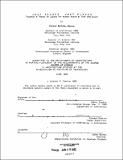| dc.contributor.advisor | Edward Robbins. | en_US |
| dc.contributor.author | Dackiw, Vladimir Nicholas | en_US |
| dc.contributor.other | Massachusetts Institute of Technology. Dept. of Architecture. | en_US |
| dc.date.accessioned | 2012-09-27T15:16:36Z | |
| dc.date.available | 2012-09-27T15:16:36Z | |
| dc.date.copyright | 1985 | en_US |
| dc.date.issued | 1985 | en_US |
| dc.identifier.uri | http://hdl.handle.net/1721.1/73265 | |
| dc.description | Thesis (M.S.)--Massachusetts Institute of Technology, Dept. of Architecture, 1985. | en_US |
| dc.description | MICROFICHE COPY AVAILABLE IN ARCHIVES AND ROTCH. | en_US |
| dc.description | Includes bibliographical references (p. 162-166). | en_US |
| dc.description.abstract | The public role of effectively guiding, evaluating and prescribing the physical places, patterns and forms we produce and live in according to commonly held external socio-political ideals has been extremely constrained by our limited knowledge of the significance and consequences of the physical environments we produce and live in, and by incomplete social and planning theories that isolate intentions from actions, processes from ideals, individuals from institutions, and space from society . Central to all of these limits of knowledge and fragments of theory is an inadequately developed theory of human act, acting, and action in space and time. We are unable to identify the significant patterns of human activity , in their forms and consequences, and we are unable to do so in an easily understandable way. Action is confused with acts and acting. For there to be an effective, significant and qualitative public debate we must first extend our knowledge of the significance and consequences of the environments we produce and live in, to include a theory of human action in these environments. Only after this theory has been developed can we effectively debate the forms that we produce according to commonly held socio-political ideals. Justice can exist in environments, and environments do contribute to justice. They can and do if we understand environments as structures of human action in time and space, and if we understand justice as a complex ideal consisting of aspects of equality, liberty, opportunity, participation, and difference. | en_US |
| dc.description.statementofresponsibility | by Vladimir Nicholas Dackiw. | en_US |
| dc.format.extent | [1], 166 p. | en_US |
| dc.language.iso | eng | en_US |
| dc.publisher | Massachusetts Institute of Technology | en_US |
| dc.rights | M.I.T. theses are protected by
copyright. They may be viewed from this source for any purpose, but
reproduction or distribution in any format is prohibited without written
permission. See provided URL for inquiries about permission. | en_US |
| dc.rights.uri | http://dspace.mit.edu/handle/1721.1/7582 | en_US |
| dc.subject | Architecture. | en_US |
| dc.title | Just spaces, just places : towards a theory of justice for human action in time and space | en_US |
| dc.title.alternative | Towards a theory of justice for human action in time and space | en_US |
| dc.type | Thesis | en_US |
| dc.description.degree | M.S. | en_US |
| dc.contributor.department | Massachusetts Institute of Technology. Department of Architecture | |
| dc.identifier.oclc | 13150107 | en_US |
